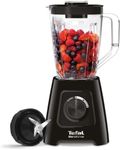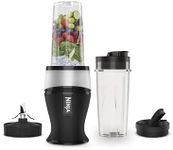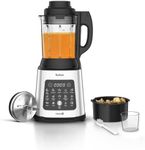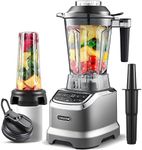Buying Guide for the Best Glass Blenders
When choosing a glass blender, it's important to consider your specific needs and how you plan to use the blender. Glass blenders are popular for their durability and ability to handle hot liquids without warping or retaining odors. They are also easy to clean and maintain. To find the best glass blender for you, consider the key specifications that will impact performance and usability.Power (Wattage)The power of a blender, measured in watts, determines how effectively it can blend different types of ingredients. Higher wattage blenders can handle tougher ingredients like ice, nuts, and fibrous vegetables more efficiently. Blenders typically range from 300 to 1500 watts. For basic tasks like making smoothies or pureeing soft fruits, a blender with 300-600 watts may suffice. For more demanding tasks like crushing ice or making nut butters, consider a blender with 700 watts or more. Choose based on the types of ingredients you plan to blend most often.
CapacityThe capacity of a blender refers to the volume of the jar, usually measured in liters or cups. This determines how much you can blend at once. Smaller blenders with a capacity of 0.5 to 1 liter are suitable for single servings or small batches. Medium-sized blenders, around 1.5 liters, are versatile for most household needs. Larger blenders, with capacities of 2 liters or more, are ideal for families or those who like to prepare large batches. Consider how many people you typically serve and choose a capacity that fits your lifestyle.
Speed SettingsSpeed settings on a blender allow you to control the blending process. More speed options provide greater control over texture and consistency. Basic blenders may have 2-3 speed settings, which are sufficient for simple tasks. More advanced models can have 5 or more speeds, plus pulse functions, which are useful for more precise blending. If you plan to use your blender for a variety of tasks, such as making smoothies, soups, and sauces, a model with multiple speed settings will offer more versatility.
Blade Material and DesignThe blades in a blender are crucial for its performance. They are typically made from stainless steel, which is durable and resistant to rust. The design of the blades can affect how well the blender processes different ingredients. Some blenders have multi-tiered blades for more efficient blending. If you plan to blend hard ingredients like ice or nuts, look for blenders with strong, sharp blades. For general use, standard stainless steel blades are usually sufficient.
Ease of CleaningCleaning a blender can be a hassle, so it's important to consider how easy it is to clean. Some blenders have dishwasher-safe parts, which can save time and effort. Others have self-cleaning functions, where you add water and a drop of dish soap, then run the blender to clean it. If you use your blender frequently, look for models that are easy to disassemble and clean. This will encourage regular use and maintenance.
Noise LevelBlenders can be quite noisy, which might be a concern if you have a sensitive household or live in a shared space. Noise levels can vary significantly between models. Some blenders are designed with noise-reduction features, which can be beneficial if you plan to use the blender early in the morning or late at night. If noise is a concern for you, consider looking for reviews or specifications that mention quieter operation.


















